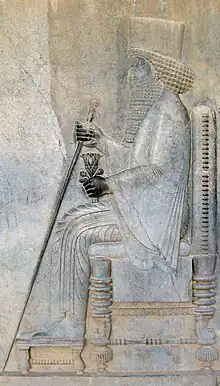Hydarnes (Old Persian: 𐎻𐎡𐎭𐎼𐎴, romanized: Vidṛna), also known as Hydarnes the Elder, was a Persian nobleman, who was one of the seven conspirators who overthrew the Pseudo-Smerdis.[1] His name is the Greek transliteration of the Old Persian name Vidṛna, which may have meant "he who knows the guilt/wrong".[1]
He was seemingly good friends with Aspathines, who invited him to join the conspiracy,[1] which included the noblemen Intaphernes, Otanes, Gobryas, Megabyzus, and the Achaemenid prince Darius, who was its leader.[2] For his services, Hydarnes was seemingly given the Achaemenid satrapy of Armenia as a semi-hereditary fief, since his descendants governed it until the Hellenistic period.[1] Orontes I (died 344 BC), the ancestor of the Orontid dynasty, was descended from Hydarnes.[3] According to some Persepolis tablets, Hydarnes served as the satrap of Media under Darius.[4]
Hydarnes was survived by two sons, Hydarnes the Younger and Sisamnes, who both served as commanders under Darius' son and successor, Xerxes I (r. 486–465 BC).[1]
References
- 1 2 3 4 5 Schmitt 2004, pp. 588–590.
- ↑ Shahbazi 1994, pp. 41–50.
- ↑ Boyce & Grenet 1991, pp. 310–311.
- ↑ Briant 2002, p. 136.
Sources
- Boyce, Mary; Grenet, Frantz (1991). Beck, Roger (ed.). A History of Zoroastrianism, Zoroastrianism under Macedonian and Roman Rule. Leiden: Brill. ISBN 978-9004293915.
- Briant, Pierre (2002). From Cyrus to Alexander: A History of the Persian Empire. Eisenbrauns. ISBN 978-1575060316.
- Schmitt, Rüdiger (2004). "Hydarnes". In Yarshater, Ehsan (ed.). Encyclopædia Iranica, Volume XII/6: Human migration II–Illuminationism. London and New York: Routledge & Kegan Paul. pp. 588–590. ISBN 978-0-933273-80-1.
- Shahbazi, Shapur (1994), "Darius I the Great", Encyclopedia Iranica, vol. 7, New York: Columbia University, pp. 41–50
